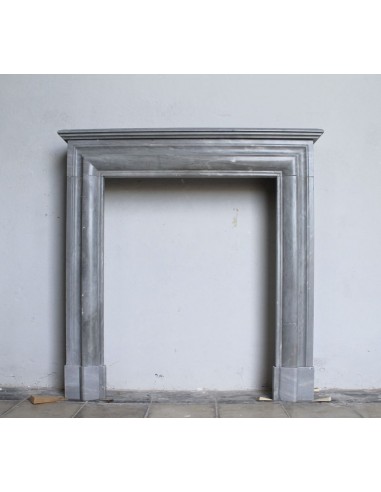PREMISE: SUCH A FIREPLACE IS VIRTUALLY UNOBTAINABLE, GIVEN THE IDIOSYNCRASY OF ITS CREATOR AND BUILDER, THE LEGENDARY BOUDIN (OPERATING ON THE CÔTE D'AZUR, BETWEEN NICE AND MARSEILLES), TO USING NON-NATIVE MARBLE.
MY SPEAKING GRILL: What are you saying, Maurizio, his marble is French, are you rambling?
ME: But dear God, we've been living together all our lives and you still haven't understood that that very fine marble “Bleu Turquin” is French only by name!? If, instead of criticizing me at every turn, you would pay a little attention, you wouldn't make such a fool of yourself....
I WILL EXPLAIN IT TO YOU FOR THE UMPTEENTH TIME:
This marble is quarried from the Apuan Alps (it would be better to say “IT WAS QUARRIED,” since of this particular and refined quality of light gray, there is almost nothing now), in its homeland it was called “BARDIGLIO TURQUIN,” but the French, very skilled traders, renamed it BLEU TURQUIN and under this appellation they marketed it throughout the Western world at “Louis Witton”-type prices, to be clear..
WE ITALIANS, ON THE OTHER HAND, WHO BELIEVE WE ARE SO FURIOUS, HAVE VALUED IT AS “GOOD AT BEST FOR MAKING FLOORS ” (see the floors of the Medici houses, almost all of them with alternating squares – like checkers – of Bianco Carrara and Bardiglio Turchino..
STRONG AND ONLY SEEMINGLY SERIOUS, SUCH A FIREPLACE WILL SUIT ANY DECORATING CONDITION.
ITS PRICE, THEN, SEEMS A MISTRANSCRIPTION, FOR HOW CAN A MID-NINETEENTH-CENTURY FIREPLACE MANTEL IN EXCELLENT CONDITION COST SUCH A DERISORY SUM?
IT'S JUST THAT WE BOUGHT IT WELL, IN FACT, VERY WELL, AND WE LIKE, WHEN POSSIBLE, TO LET OUR CUSTOMERS SHARE IN THE GOOD DEAL STRUCK, THAT'S ALL.
I WRITE THESE THINGS BECAUSE I WOULD NEVER WANT YOU TO EVALUATE THIS ARTIFACT ONLY CONSIDERING ITS LOW PRICE.
PROVENANCE BLUE COAST, ERA OF CONSTRUCTION 1840-60.
Editor's note: Yesterday I got a call from a possible customer asking me what those white “spots” are on the marble surface of this fireplace. Well, they are not “spots” but very normal and natural fossils, such as there are in almost all the marbles of the globe. They are like WHITE CLOUDS ON A SKY.... TURQUOISE, WOE IF THEY WERE NOT THERE, A FLAT SKY WOULD LACK POETRY....
LATIN NOTES:
ECOLOGY AND ANCIENT FIREPLACES, A VERY TOPICAL COMBINATION.
Take note, for the past few years it has been all about adding the prefixes “ECO” and “BIO” to any product, and even the fireplace does not escape this publicity deception.....
I won't give you the name of the company because otherwise they will sue me, but there is even a fireplace manufacturer who brought up Geppetto's fireplace (Pinocchio's, eh..) just because Geppetto rhymes with bio-fireplace, forgetting the fact that the “real” Geppetto was so poor, but so poor that he had the fire, at home, yes, but ... painted on the wall !!!
In truth, modern fireplaces (mostly produced in China, India or Pakistan and then marketed in Italy after finely labeling them..) have very little ecological about them, since they are produced through the use of chemical components in their processing (that's how it's done faster..), especially in polishing and assembly, resulting in the production of sludge that is highly toxic to humans and the environment..
ASIDE NUMBER 1: IN YOUR OPINION, IN CHINA OR SIMILAR PLACES (BUT ALSO IN ITALY, CAMORRA DOCET..), WHAT HAPPENS TO THAT SLUDGE!
Besides, and this is a sad key, we all know that in those countries, in order to save money, they enslave even children for the most toxic jobs....
ASIDE NUMBER 2: ACCORDING TO YOU, IN BANGLADESH (BUT I COULD WRITE A HUNDRED OTHER DERELICT COUNTRIES..) IS THERE CONTROL OVER CHILD LABOR!
(That's Ecology too, maybe “Moral Ecology,” but... let's reflect, isn't that important too?!) So what to do?
What can we do in the face of this issue!
Well, in our own small way, something we can do, we can try to direct everyone to THE CERTAINLY MOST ECOLOGICAL FIREPLACE OF ALL, THE ANCIENT ONE !
An antique fireplace is made of a marble or stone that has already been quarried, and therefore does not need newly quarried materials.. Our Apuan Alps, already so disrupted by millennia of quarrying, certainly do not need any more scarring, and this also applies to all the quarrying areas everywhere in the world, now wildly (especially in the so-called “emerging” countries..) disfigured in their appearance and morphology with the inevitable hydrogeological consequences.
Another “ecological” point in favor of the ancient fireplace lies in the fact that ancient fireplaces were assembled with entirely natural materials (especially plaster) and not with plastic or silicone mastics as is the case today. Their carving, then, was entirely manual, and did not produce those waste slurries that modern machines (“PANTOGRAPHERS”) spit out with each piece and which we then, perhaps, find ourselves illegally dumped in the sea or in some disused quarry given the high cost of their disposal by law... In short, it can certainly be said that the antique fireplace IS ECOLOGICAL AND WAS ECOLOGICAL even at the time of its construction!
Last thought and then I will not bore you any more:
If it is true that respect for the environment can only be achieved through greater culture, well every antique fireplace carries in its forms and veins a little bit of culture, the appeal of which even the most insensitive individual will not be able to escape..
It will be a cultural and economic, as well as an environmental, investment for you to put a truly artistic artifact in your home.
Cheers (which is the most important thing..) to you, from Maurizio and Enrico Dal Pezzo








































































